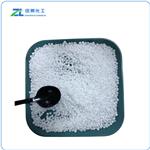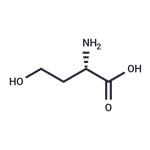- L-homoserine
-

- $50.00 / 1kg
-
2024-12-20
- CAS:672-15-1
- Min. Order: 1kg
- Purity: 99
- Supply Ability: 5000
- L-Homoserine
-

- $0.00 / 1KG
-
2024-12-13
- CAS:672-15-1
- Min. Order: 1KG
- Purity: 98.0%
- Supply Ability: 5000kg/month
- L-Homoserine
-

- $30.00 / 100mg
-
2024-11-19
- CAS:672-15-1
- Min. Order:
- Purity: 99.42%
- Supply Ability: 10g
|
| | L-Homoserine Basic information |
| | L-Homoserine Chemical Properties |
| Melting point | 203 °C (dec.)(lit.) | | Boiling point | 222.38°C (rough estimate) | | alpha | -8.5 º (c=2, H2O 22 ºC) | | density | 1.3126 (rough estimate) | | refractive index | 1.4183 (estimate) | | storage temp. | Store below +30°C. | | solubility | 1100g/l | | form | Crystalline Powder | | pka | 2.71(at 25℃) | | color | White to light yellow | | optical activity | -8.825 (H2O) +18.326 (2 mol dm-3 HCl) | | Water Solubility | 1100 g/L (30 ºC) | | Merck | 14,4739 | | BRN | 1721681 | | InChIKey | UKAUYVFTDYCKQA-VKHMYHEASA-N | | LogP | -1.289 (est) | | CAS DataBase Reference | 672-15-1(CAS DataBase Reference) |
| | L-Homoserine Usage And Synthesis |
| Chemical Properties | white to light yellow crystalline powder | | Uses | L-Homoserine is used in the biosynthesis of methionine, threonine and isoleucine. It is also used as an internal standard for neurotransmitter analysis and amino acids quantification. | | Definition | ChEBI: L-homoserine is the L-enantiomer of homoserine. It has a role as a human metabolite, an algal metabolite, a Saccharomyces cerevisiae metabolite and an Escherichia coli metabolite. It is an enantiomer of a D-homoserine. It is a tautomer of a L-homoserine zwitterion. | | Synthesis Reference(s) | Journal of the American Chemical Society, 80, p. 3147, 1958 DOI: 10.1021/ja01545a057
The Journal of Organic Chemistry, 24, p. 1794, 1959 DOI: 10.1021/jo01093a610 | | General Description | L-Homoserine is a variant of serine with an additional carbon on its side chain. | | Biochem/physiol Actions | L-Homoserine is synthesized by deoxidation process, catalysed by homoserine dehydrogenase. This is one of the steps in the synthesis of L-threonine. The carbon flux in in bacteria such as E. coli is maintained by this reaction. | | Purification Methods | Likely impurities are N-chloroacetyl-L-homoserine, N-chloroacetyl-D-homoserine, L-homoserine, homoserine lactone, homoserine anhydride (formed in strong solutions of homoserine if slightly acidic). It cyclises to the lactone in strongly acidic solution. It crystallises from water by adding 9 volumes of EtOH. [Greenstein & Winitz The Chemistry of the Amino Acids J. Wiley, Vol 3 pp 2612-2616 1961, Beilstein 4 IV 3187.] |
| | L-Homoserine Preparation Products And Raw materials |
|